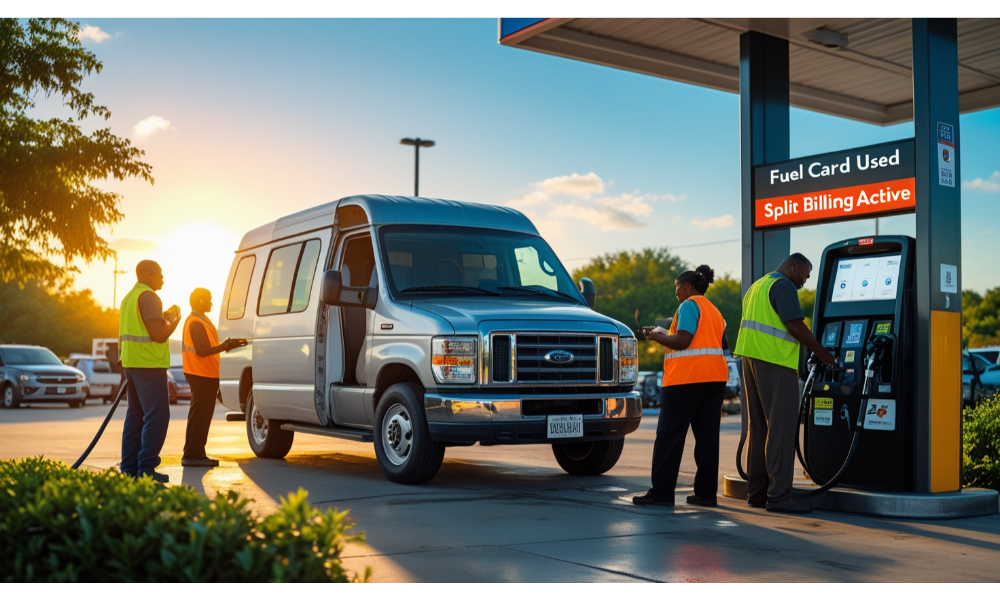Fleet Fuel: How to Manage Spending More Efficiently
Fuel costs can account for up to 60% of total fleet operating expenses, making efficient fuel spend management an essential strategy for business success. With evolving technologies and the growing need for accountability, organizations are turning to advanced fleet fuel cards to track transactions, control driver usage, and optimize fuel savings across locations and vehicle types.
According to recent findings by Fleet Management Weekly, companies that implement GPS-enabled transaction tracking and automated reporting systems see an average 15–20% reduction in monthly fuel expenses. One such system is ’s fleet card, which offers customizable spending controls, integration with ERP platforms, and acceptance at over 95% of U.S. fueling stations. These cards also support budgeting, mileage analysis, and balance tracking, giving managers real-time visibility into account activity, transactions, and expenses across teams and vehicles.
Fuel Spend Tracking Is Foundational to Fleet Efficiency
Effective tracking is the starting point for reducing unnecessary costs. Many organizations still rely on manual reimbursement methods or use credit cards with limited category restrictions, which hinders visibility into usage trends and spending behavior. A study by Exxon (2024) found that companies with automated fuel spend tracking systems experience 23% fewer data entry errors and 19% lower administrative costs on average.
Fuel card platforms like ’s offer:
Detailed transaction monitoring, updated in real time via mobile and desktop tools
Analytics dashboards that break down fuel usage by vehicle, driver, or location
Spending alerts and digital receipts, reducing administrative overhead
This visibility allows businesses to analyze per-vehicle fuel consumption, evaluate average cost per gallon across stations, and monitor usage trends linked to engine performance or idle time. Expense tracking through automated tools ensures that discrepancies, such as excessive fuel purchases or route anomalies, are addressed promptly. When integrated with credit approval systems and usage-based policies, companies can customize limits to suit different departments and business needs.
Custom Spending Controls Reduce Fuel Fraud and Abuse
Fuel misuse remains a persistent issue across commercial fleets. In a 2023 survey by Fleet Management Magazine, 36% of fleet operators cited unauthorized fueling as a primary budget concern. With diesel and gasoline prices fluctuating and averaging $3.85 per gallon in Q1 2025 according to the U.S. Energy Information Administration, fuel fraud has a more direct impact on operating margins than ever.
’s fleet card includes several fraud-prevention controls:
Spending limits by card, vehicle, or location
Category-specific restrictions, e.g., for gasoline or premium diesel
PIN-based transaction authorization
Time and location-based usage policies
Combined with account alerts, customer service escalation tools, and historical reports, these controls assist in identifying anomalies such as inconsistent mileage, duplicate fill-ups, or non-fleet vehicle usage-strengthening reimbursement oversight and card security. Alerts can be customized based on risk thresholds, enabling proactive rather than reactive fraud management. Some programs use advanced fraud detection algorithms to flag unusual transaction patterns, such as unexpected purchases at truck stops or pumps outside of authorized service areas.
Integrated Analytics and Reporting Drive Smarter Decision-Making
Fleet operators increasingly turn to data-driven platforms to manage variable costs. According to Deloitte’s Fleet Insights 2024, businesses with real-time reporting capabilities outperform peers by up to 25% in fuel spend predictability. Organizations with robust reporting tools also saw a 14% improvement in budgeting accuracy and a 17% boost in fuel efficiency per vehicle over 12 months.
’s fleet platform supports:
Automated expense exports to ERP systems and fleet management software
Comparative dashboards to flag cost anomalies and driver-specific usage
Granular tracking of transaction frequency, vehicle mileage, and fuel type per vehicle
By integrating these insights into larger fleet management tools, businesses can assess fuel economy, plan vehicle replacements, and benchmark driver performance. Some organizations use this data to adjust refueling schedules or assign drivers based on historical efficiency. Fuel economy benchmarks tied to make, model, region, and service application enable deeper optimization and reduce total cost of ownership.
Network Coverage and Station Access Keep Fleets Productive
Widespread access to fueling stations reduces downtime and ensures route efficiency. ’s fleet card is accepted at over 95% of U.S. gas stations, including brands such as , , , , , and . This reach lowers out-of-network spending and supports access to fuel discounts based on volume, fueling frequency, or service region.
The app supports:
Station locators with real-time pricing and diesel/gasoline availability
Filters for alternative fuels or preferred pricing networks
Mobile integration for purchase approval, fraud detection, and transaction tracking
These tools improve service consistency, offer more reliable budgeting, and promote price-aware driver behavior. For example, one field services company used network mapping features to consolidate fueling to 15 preferred locations, reducing overall spend by 8% within three months. With real-time data, drivers can avoid high-price stations and receive recommendations based on fuel price, type, and location. Combined with controls on gallon limits and route compliance, these features maximize fleet efficiency.
Seamless ERP and Telematics Integration
Modern fleet operations depend on system interoperability. According to McKinsey, fleets that link ERP platforms and telematics software report 18% greater administrative efficiency. Companies that combine fuel card programs with their fleet management platforms also report up to 30% faster end-of-month reconciliation, per a 2023 report by Fleetio.
’s fleet program facilitates:
Fleetwide spend summaries categorized by fuel type, driver, and job code
Integration with third-party logistics, routing, and maintenance platforms
Mileage-to-fuel usage tracking, supporting warranty compliance and fleet insurance reporting
This integration turns disparate operational data into unified reports, helping companies budget more accurately, spot underperforming vehicles, and strengthen compliance. When paired with payroll, loan servicing, or reimbursement platforms, it reduces the need for duplicate data entry. As telematics systems become more common, businesses can use integration to align refueling behavior with idle time, maintenance needs, and route deviations, improving overall performance and reducing operational risk.
Real-Time Alerts and Mobile-Based Controls Improve Oversight
Real-time access to transaction data is critical for controlling fleet costs. With mobile-based platforms, managers can instantly respond to exceptions. This is especially valuable for industries with dispersed fleets-such as construction, HVAC, and logistics-where oversight from a central office may not be feasible without mobile access.
The Fleet Card app enables:
Monitoring of balance, purchase volume, and usage caps per driver
Adjustments to fleet card limits, approval workflows, and transaction alerts
Real-time spending pattern recognition for fraud prevention and route compliance
These features enable a higher level of control across teams, vehicles, and roles. Role-based access, for instance, allows supervisors to manage their teams while still maintaining enterprise-level control structures. The app also allows for immediate adjustments in card permissions, ensuring flexibility when business needs shift. Integration with credit score tools and EV charging stations is becoming more common as fleets diversify their vehicle types.
Aligning Fuel Spend With Broader Operational Goals
Fuel cost insights have implications for operational planning. ’s platform provides data that can be cross-referenced with tire wear, mileage efficiency, engine diagnostics, and scheduled maintenance to:
Flag high-consumption vehicles or irregular gallon fills
Anticipate breakdowns based on fuel efficiency shifts
Improve delivery timing and reduce deadhead miles
When combined with metrics like average transaction value, route fuel cost, vehicle performance, and card usage frequency, these insights support holistic cost optimization. Over time, this contributes to reduced carbon emissions and better compliance with environmental regulations. Businesses focused on sustainability can also use the platform’s emissions-tracking data to inform ESG reporting, while integrating fleet policies with HR and safety compliance programs.
Fleet Applications Across Industries
Fuel management tools must scale across verticals. In the trucking industry, large fleets use bulk discounts and detailed consumption analytics to reduce per-mile costs. In contrast, small business fleets in landscaping, HVAC, or regional shipping often focus on visibility and fraud reduction. Fleet card solutions like ’s are tailored to meet both use cases.
For instance:
Construction fleets use mobile controls and route-based insights to manage on-site fueling needs
Delivery services monitor stop frequency and card usage to spot inefficiencies
Utility and service fleets use integration to align fueling with customer visit patterns and scheduling software
Each scenario benefits from centralized reporting, improved compliance, reduced risk, and simplified expense management. By leveraging features such as driver-level analytics, location-based restrictions, mobile app integration, and fraud alerts, businesses can customize their card programs to match operational realities.
Key Takeaways for Operations Leaders
Effective fleet fuel programs do more than reduce fuel costs-they improve accountability, operational efficiency, and financial forecasting. When paired with category-specific controls and app-based oversight, they enable strategic improvements across vehicle and driver operations.
Data from ATRI’s 2024 Operational Costs of Trucking report shows that fleets using smart fuel tracking solutions save an average of 5.7 cents per mile-highlighting the value of integrated tools for real-world savings. Additional analysis shows that fleets with automated alerts experience 28% faster issue resolution in expense disputes. The American Transportation Research Institute also notes that companies using rebate-eligible card networks saw an average 12% annual improvement in cost-per-mile metrics.
Driving Efficiency Through Data and Access
Integrated platforms like ’s can transform how businesses manage payments, vehicle fuel costs, maintenance scheduling, and purchase behavior. With broad network access, automated analytics, and mobile-first controls, businesses gain the tools to align spending with operational priorities.
To benchmark your fleet’s current fuel economy or evaluate gaps in spend oversight, explore how fleet fuel card solutions compare across industries. Accessing third-party case studies, industry benchmarks, and product-specific reports is a critical step toward reducing cost variability, enhancing compliance, and optimizing every transaction.
















